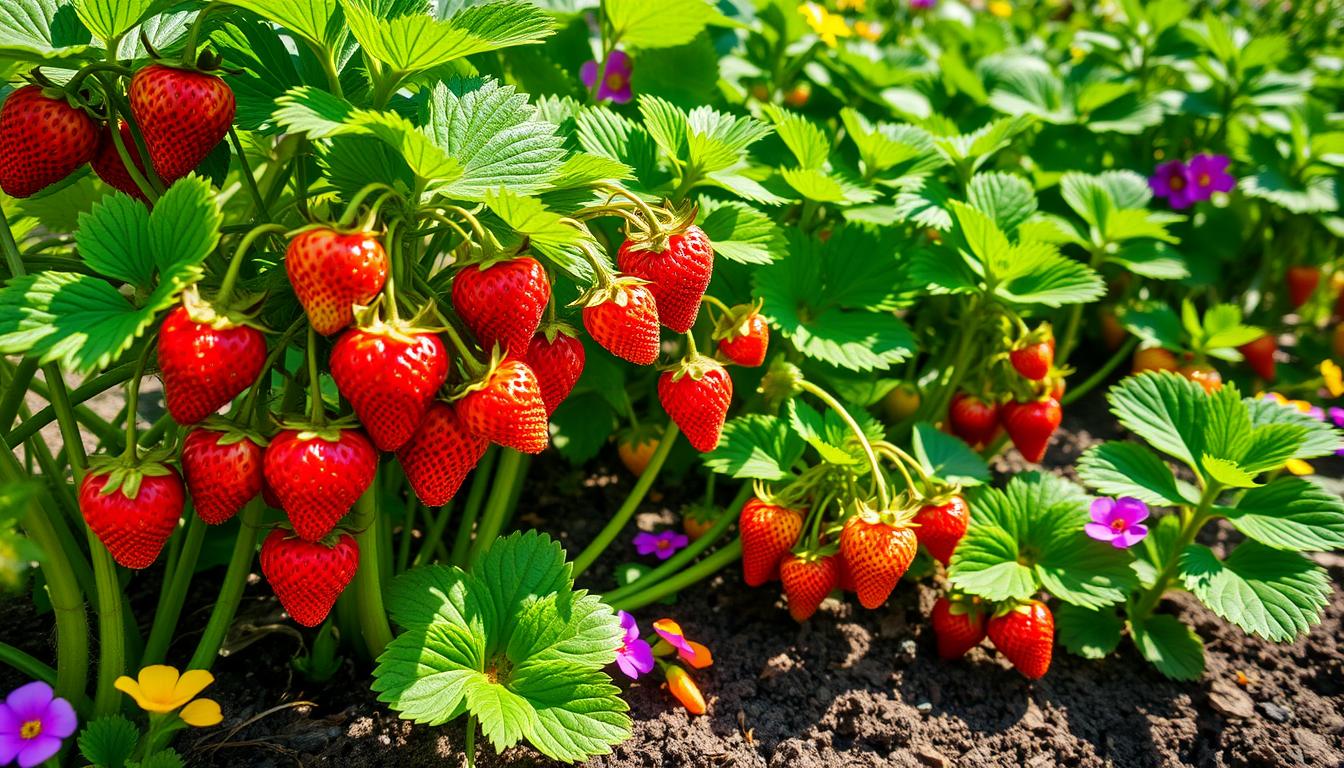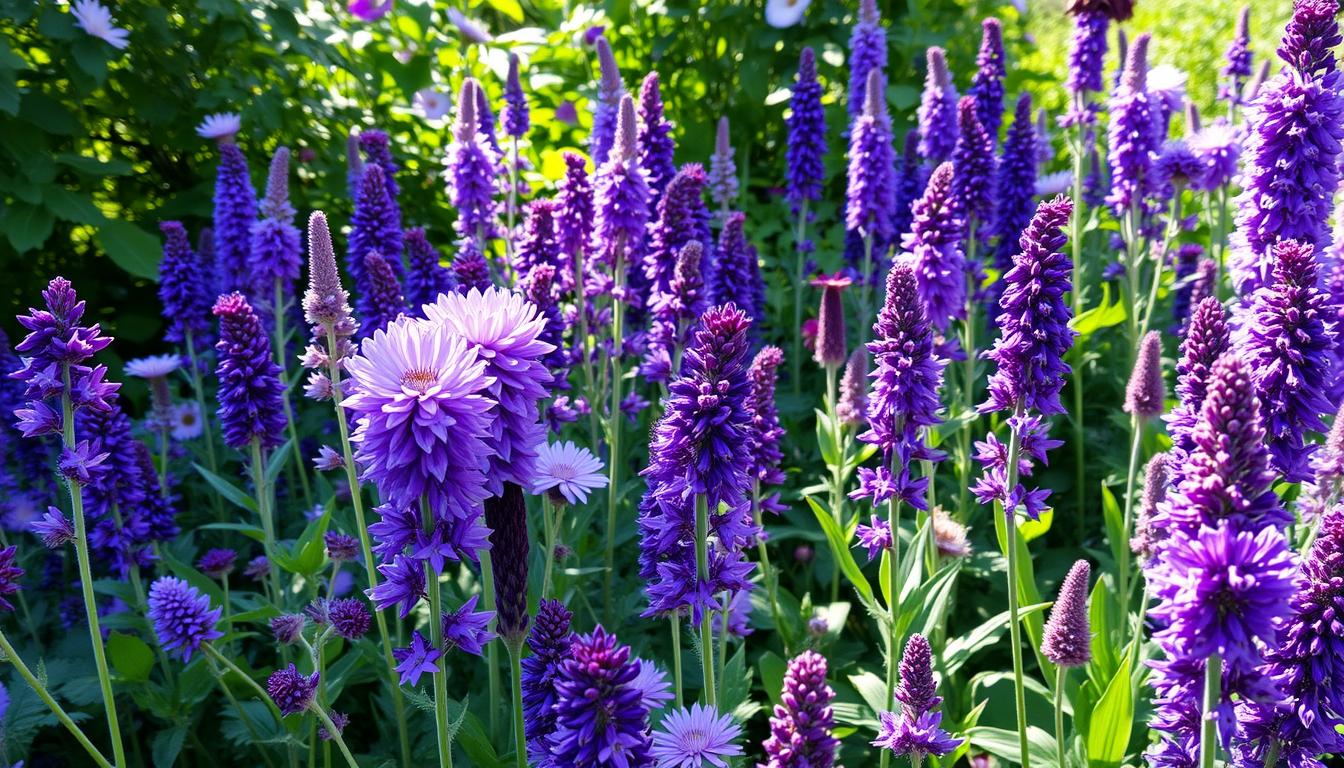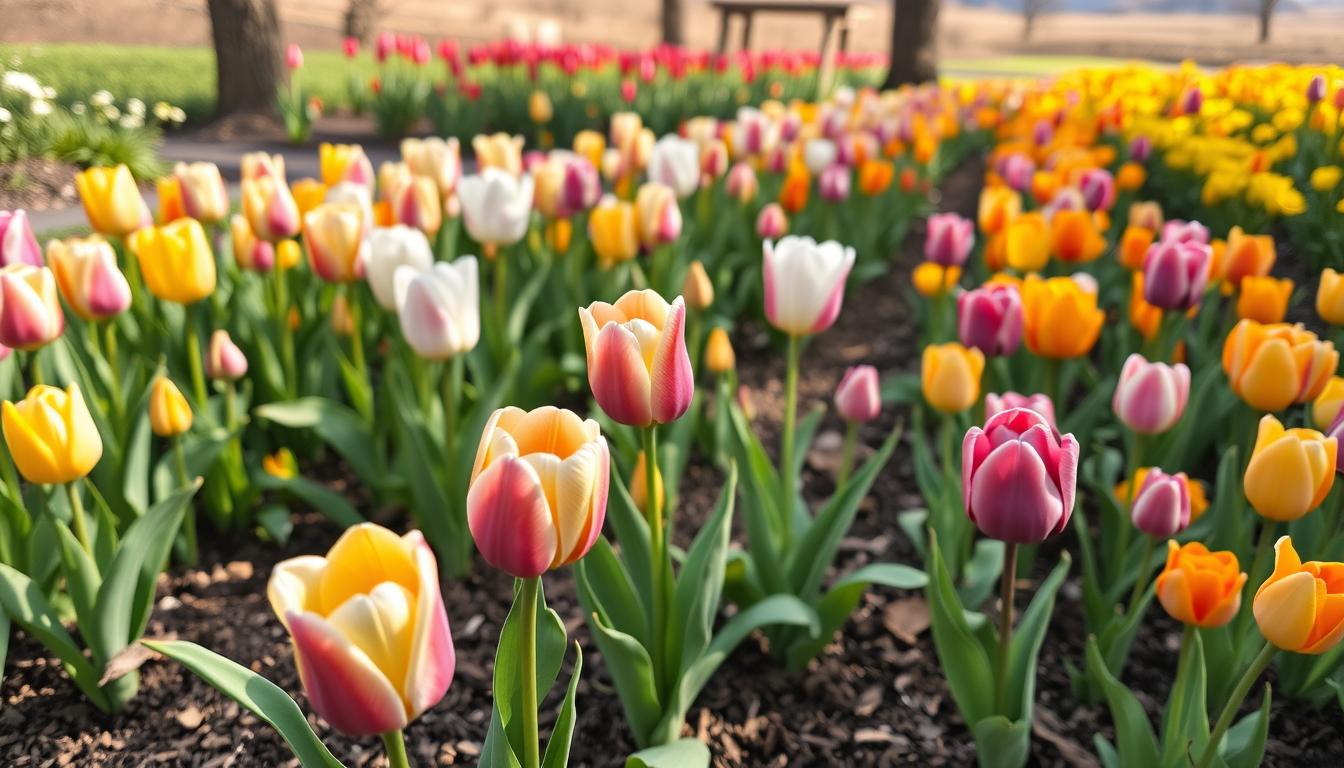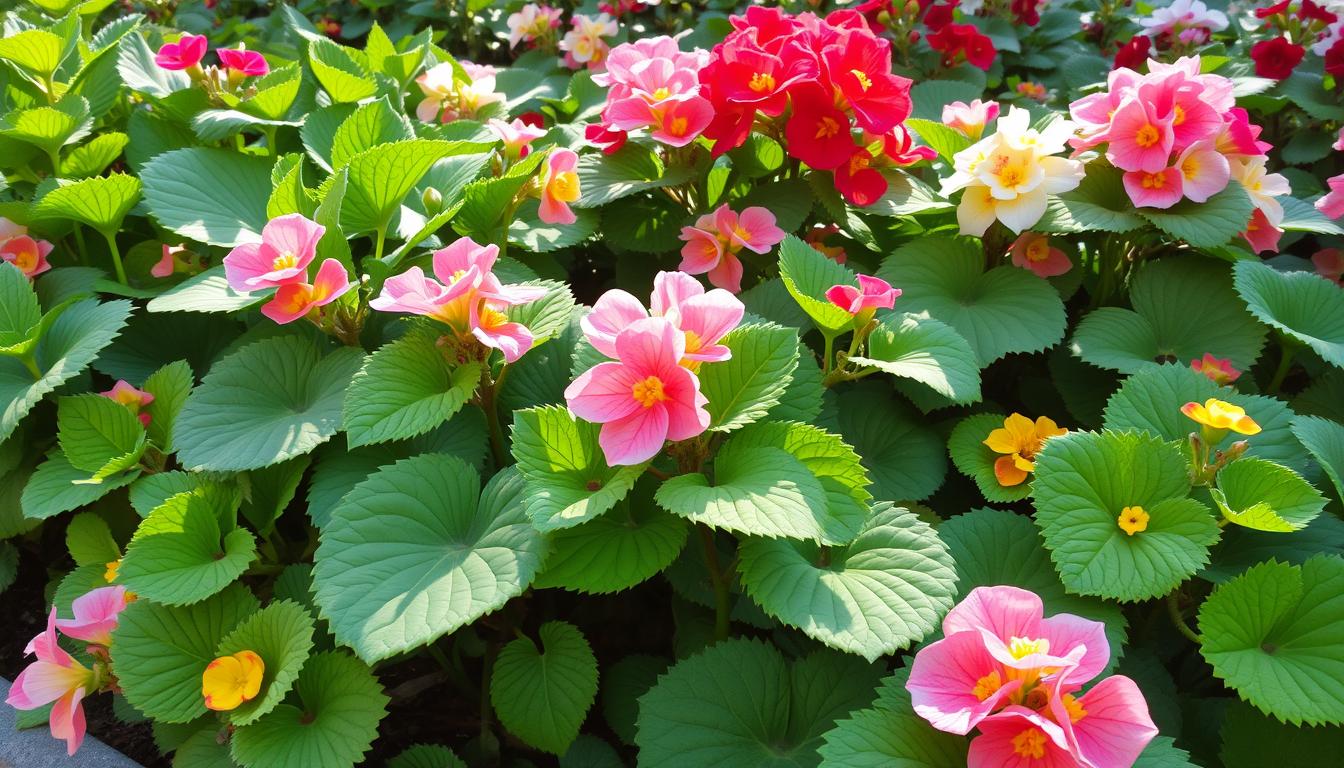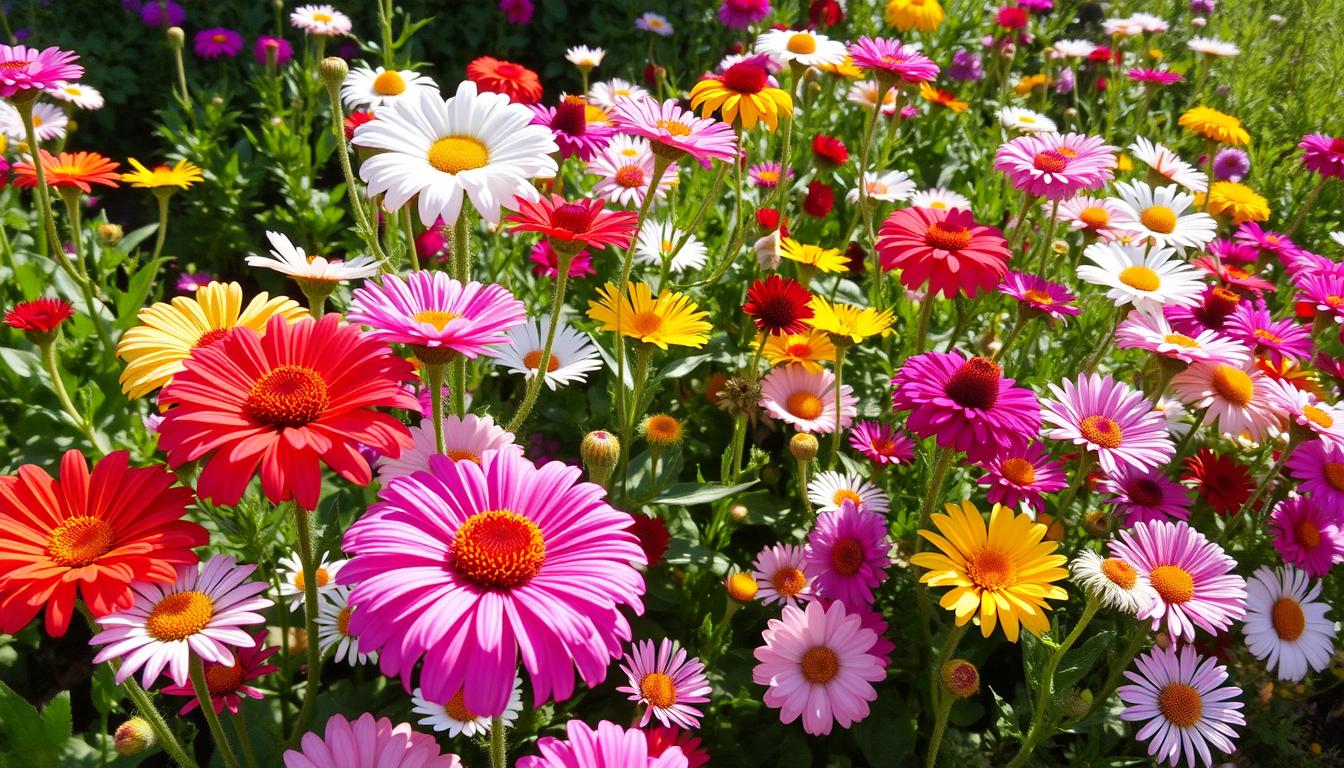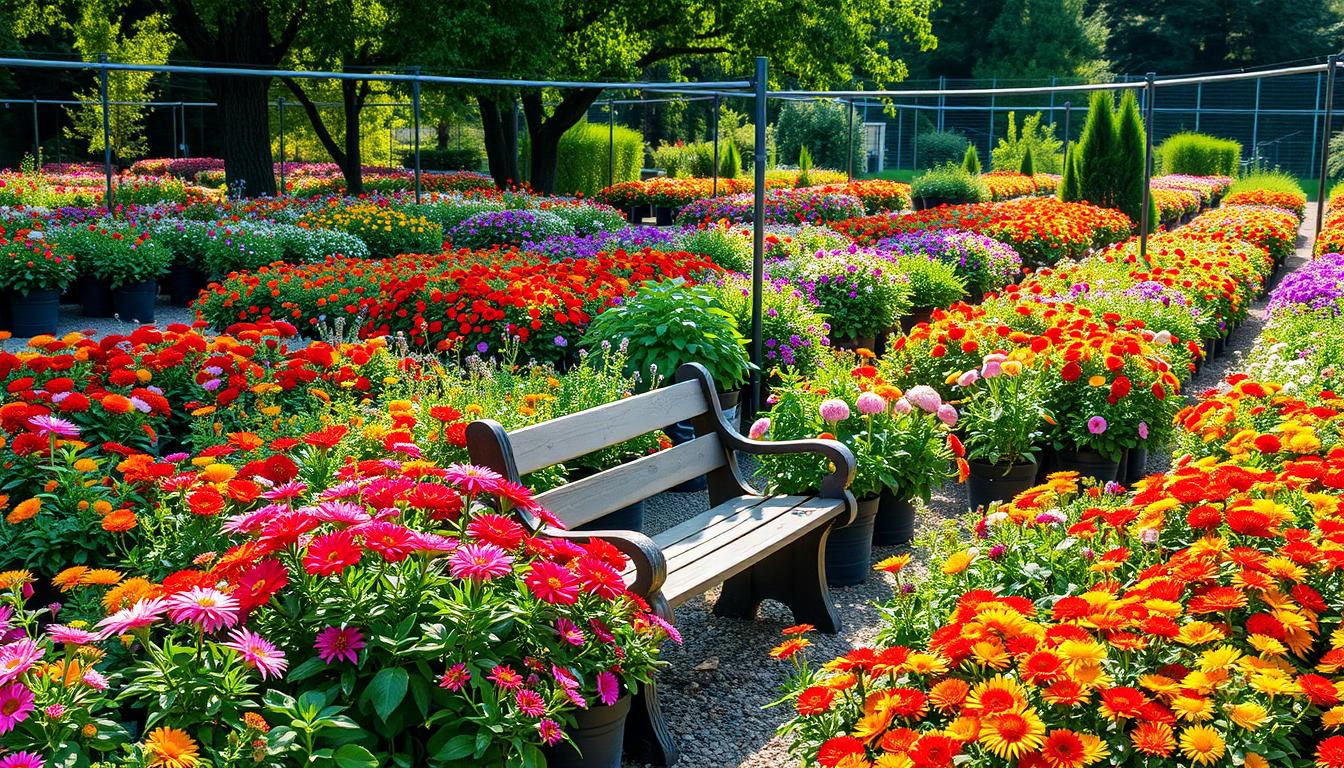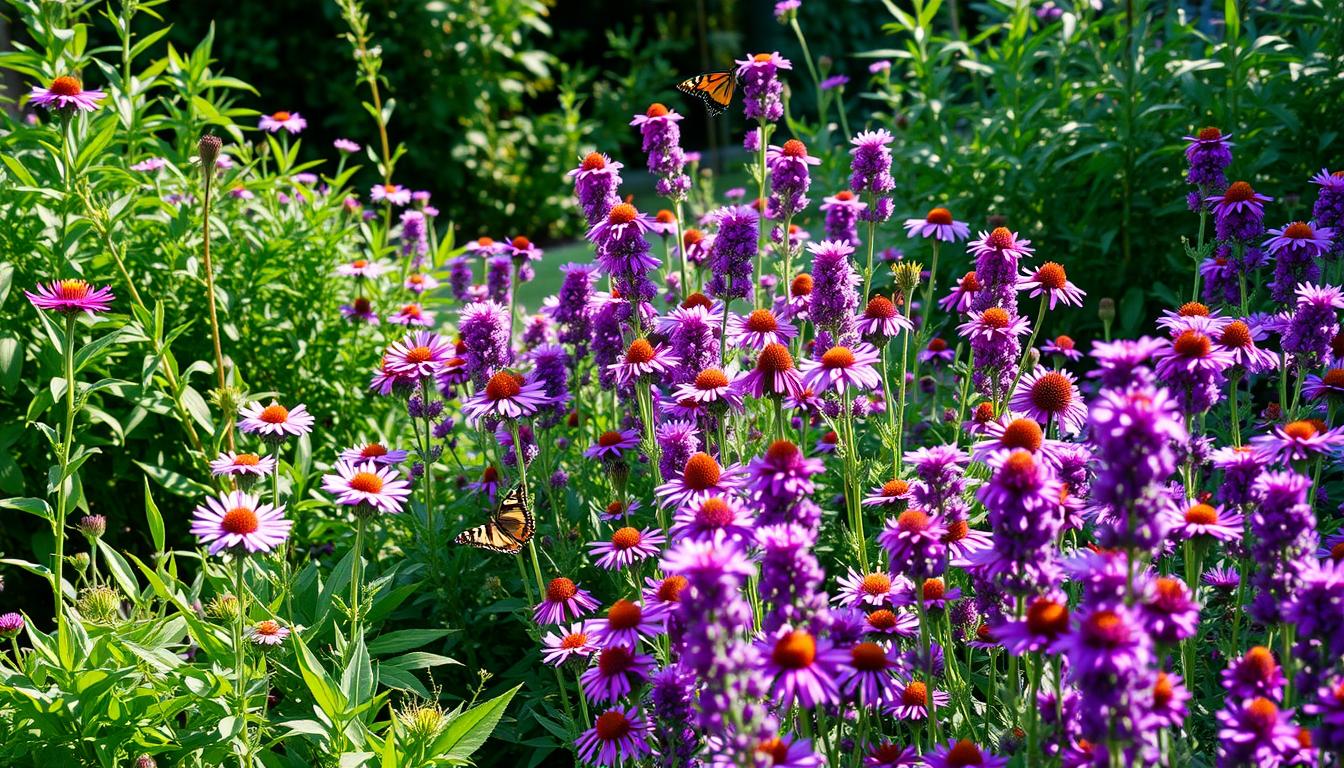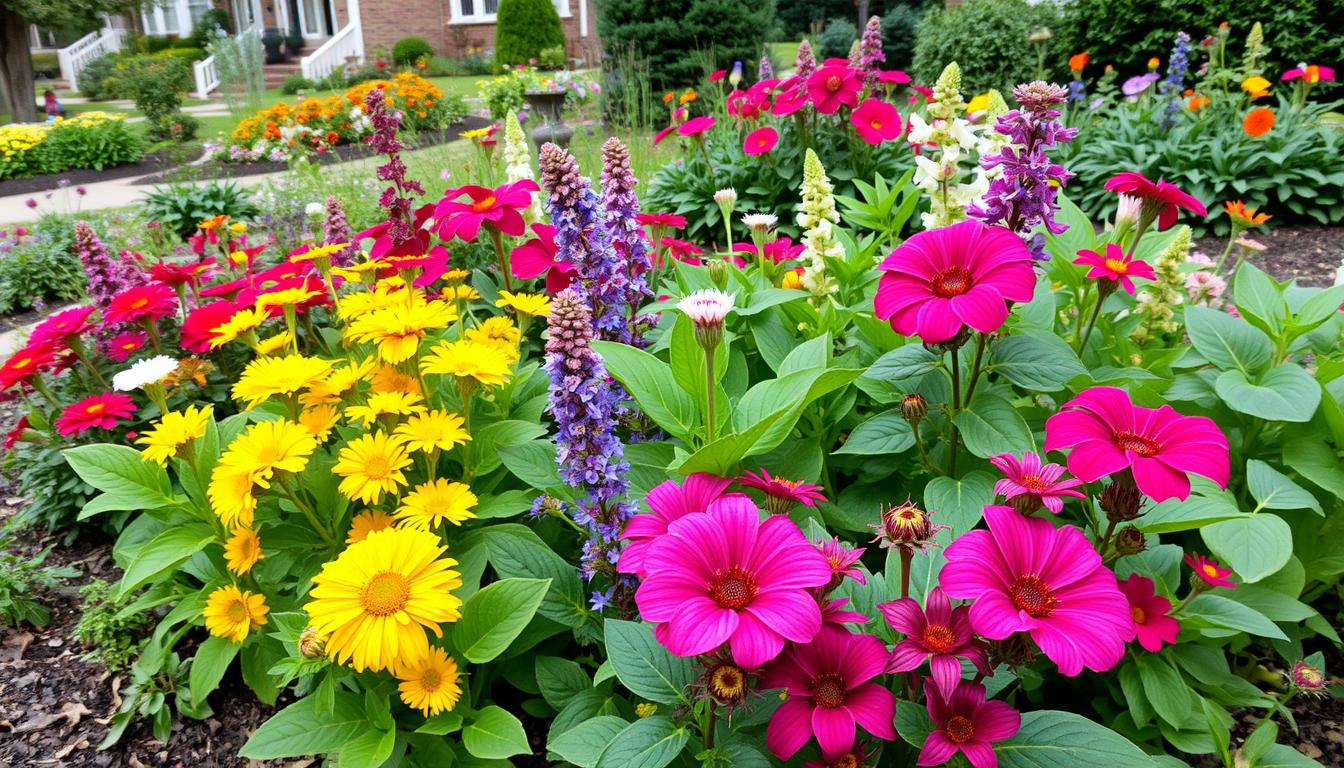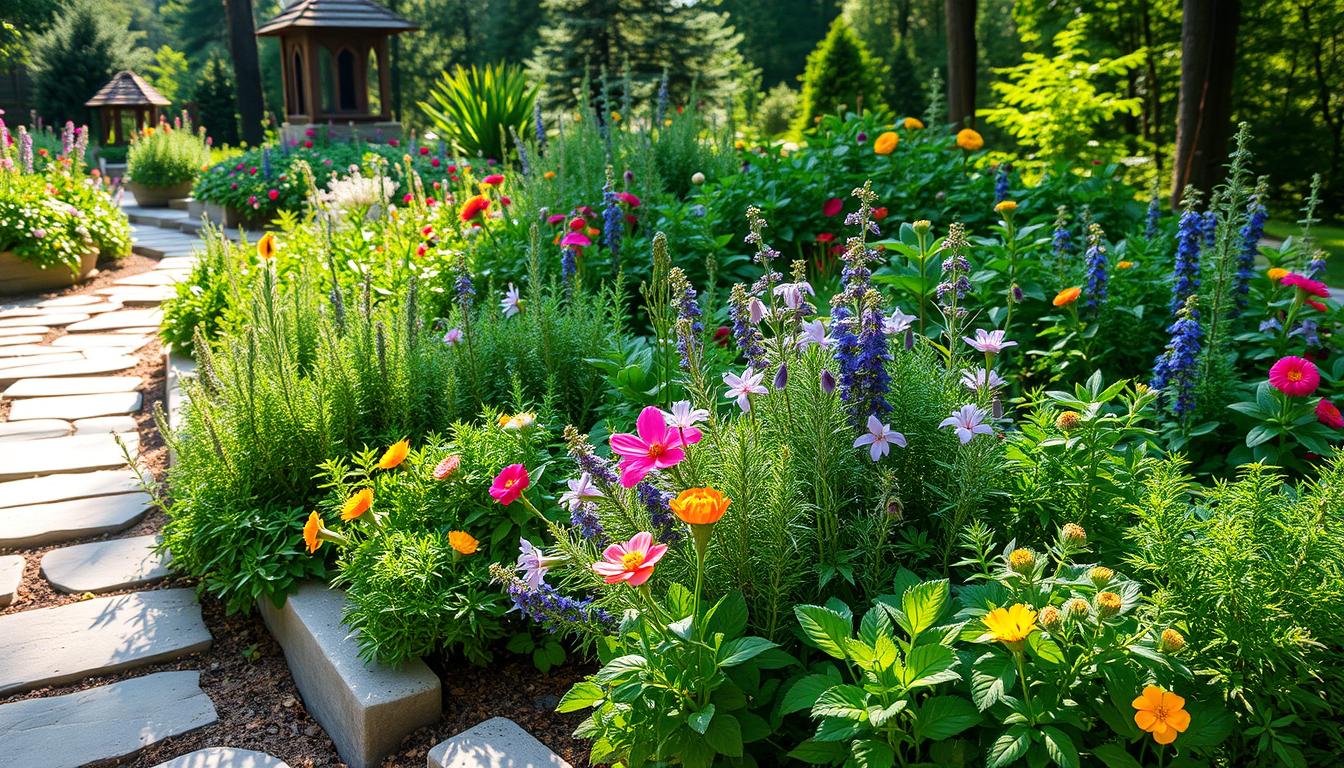Imagine walking into your backyard and picking fresh strawberries right from the plant. You can do this all season long, not just for a few weeks. Growing everbearing strawberry plants makes this dream come true.
Everbearing strawberry plants are a gardener’s secret for a steady supply of sweet strawberries. Unlike June-bearing varieties, they give you two to three harvests from spring to fall. This means you can enjoy fresh strawberries for months, not just weeks.
Your backyard can become a strawberry paradise with these plants. They fit well in any space, from big gardens to small patios. They’re great for gardeners who want a constant supply of fresh berries without the usual strawberry variety limits.
Choosing everbearing strawberry plants opens up a world of gardening joy. You get fresh fruit, easy care, and the happiness of picking your own strawberries all season long.
Table of Contents
What Are Everbearing Strawberry Plants?
Everbearing strawberry plants are a special choice for gardeners wanting fruit all season. They don’t just grow once like June-bearing strawberries. Instead, they give you multiple harvests, perfect for small gardens and spaces.
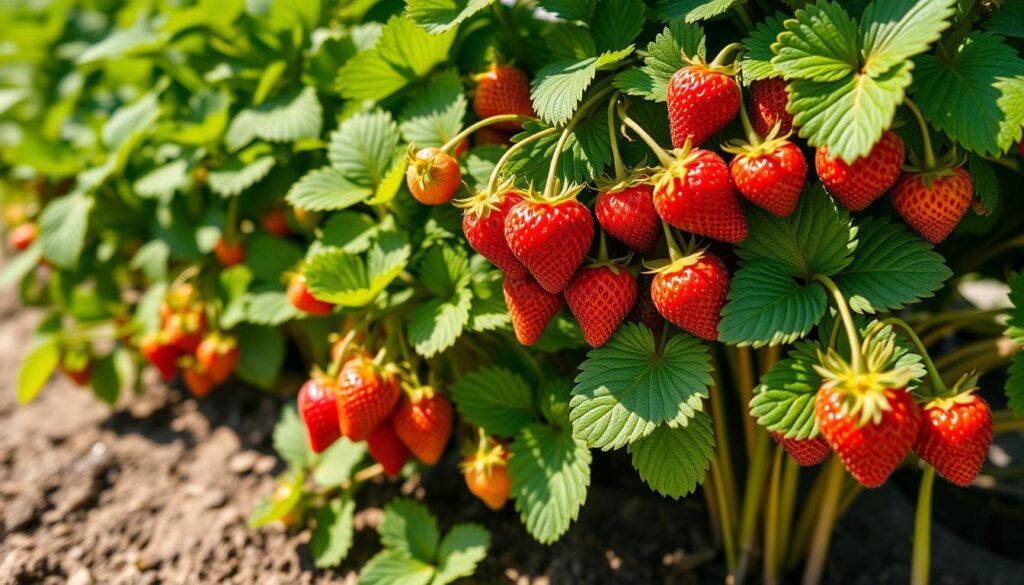
Exploring everbearing strawberry plants opens up a new way to grow fruit. These best everbearing strawberry plants let you enjoy fruit for longer, with 2-3 harvests each season.
Characteristics of Everbearing Varieties
- Produce multiple fruit cycles per growing season
- Smaller fruit compared to June-bearing varieties
- Adaptable to various growing conditions
- Ideal for container gardening and small spaces
| Characteristic | Everbearing Strawberries | June-bearing Strawberries |
|---|---|---|
| Harvest Cycles | 2-3 per season | 1 large crop |
| Fruit Size | Smaller | Larger |
| Growing Flexibility | High | Limited |
Benefits of Everbearing Strawberries
Everbearing strawberry plants offer more than just lots of fruit. They grow well in many places, from gardens to hanging baskets. Their steady fruit production makes them a favorite for gardeners wanting a reliable harvest.
“Everbearing strawberries transform your garden into a continuous fruit-producing paradise.” – Gardening Expert
Choosing the best everbearing strawberry plants means you’ll have fresh strawberries from spring to fall. Your garden will be full of sweet, nutritious fruit all season long.
Best Everbearing Strawberry Varieties to Grow
Choosing the right strawberry variety is key to a successful garden. If you’re looking to buy everbearing strawberry plants, knowing their traits is essential.

Everbearing strawberries give gardeners a big plus: they produce fruit all season long. These plants offer berries from early summer to fall. They’re perfect for home gardens.
Popular Varieties to Consider
Looking for the best everbearing strawberry plants? Here are some top picks:
- Fort Laramie: Extremely cold-hardy variety
- Ozark Beauty: Known for robust flavor and high yield
- Seascape: Exceptional performance in various climates
- Quinault: Large, sweet berries with consistent production
Taste and Yield Comparisons
Different everbearing strawberry varieties have unique tastes and yields. Here’s a quick comparison:
“Not all strawberries are created equal – each variety brings its own special characteristics to your garden!” – Gardening Expert
When buying everbearing strawberry plants, think about:
- Berry size
- Flavor intensity
- Disease resistance
- Adaptability to your local climate
With the right choice, you can enjoy fresh strawberries all season.
Ideal Growing Conditions for Everbearing Strawberries
Creating the perfect environment is key for growing everbearing strawberry plants. These plants are sensitive and need specific conditions to thrive. They must produce plenty of fruit all season long.

Soil Requirements for Healthy Growth
Soil preparation is the first step in caring for everbearing strawberry plants. They need well-drained, loamy soil with a certain pH level. This ensures they grow well and produce lots of fruit.
- Ideal soil pH: 5.5 to 6.8
- Soil type: Loamy with excellent drainage
- Organic matter content: High for nutrient retention
- Recommended planting depth: 2-3 inches
Sunlight and Temperature Needs
Sunlight is crucial for everbearing strawberry plants. They need direct light to grow well and produce fruit all season.
| Growing Condition | Requirement |
|---|---|
| Daily Sunlight | 6-8 hours of direct sunlight |
| USDA Growing Zones | Zones 3-10 |
| Plant Spacing | 12-24 inches apart |
| Mature Plant Height | 8-10 inches |
“The secret to bountiful strawberries lies in understanding and meeting their specific environmental needs.”
When picking a spot for your strawberry patch, choose areas with lots of sun. Make sure they’re also protected from strong winds. Creating a microclimate with the right temperature and air flow is important.
By managing soil, sunlight, and temperature well, your everbearing strawberry plants will give you delicious fruits all season.
How to Plant Everbearing Strawberries
Growing everbearing strawberry plants is fun and rewarding. These fruits give you multiple harvests all season. They’re great for those who want fresh produce often.
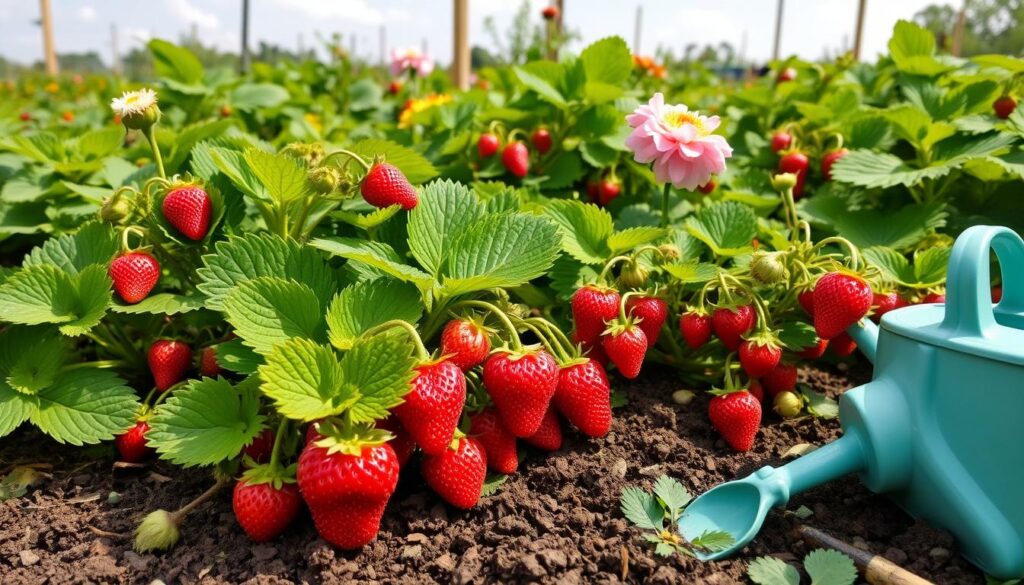
Before planting your organic everbearing strawberry plants, know the key steps and best conditions for success.
Preparing Your Planting Site
Choose a spot with full sun and well-drained soil. Strawberries need at least 6-8 hours of sunlight a day. To prepare your garden:
- Remove weeds and rocks
- Loosen soil to 12 inches deep
- Add organic compost to enrich the soil
Planting Techniques
Here’s how to plant your strawberry crowns:
- Space plants 12-24 inches apart
- Plant at a depth of 2-3 inches
- Make sure the crown is just above the soil
- Water well after planting
| Planting Time | Recommended Action |
|---|---|
| Early Spring | Plant as soon as soil is workable |
| Late Fall | Plant 6 weeks before first frost |
Best Planting Seasons
The best time to plant varies by your climate. Experienced gardeners suggest planting in early spring or late fall. This matches your USDA hardiness zone.
“Success in growing strawberries begins with understanding your local growing conditions.” – Gardening Expert
Pro tip: Always check your local extension office for precise planting dates specific to your region.
Caring for Your Everbearing Strawberry Plants
Growing healthy everbearing strawberry plants needs careful attention. You must know their needs and give them the best growing conditions. By following key strategies, you can increase fruit and keep your plants healthy.
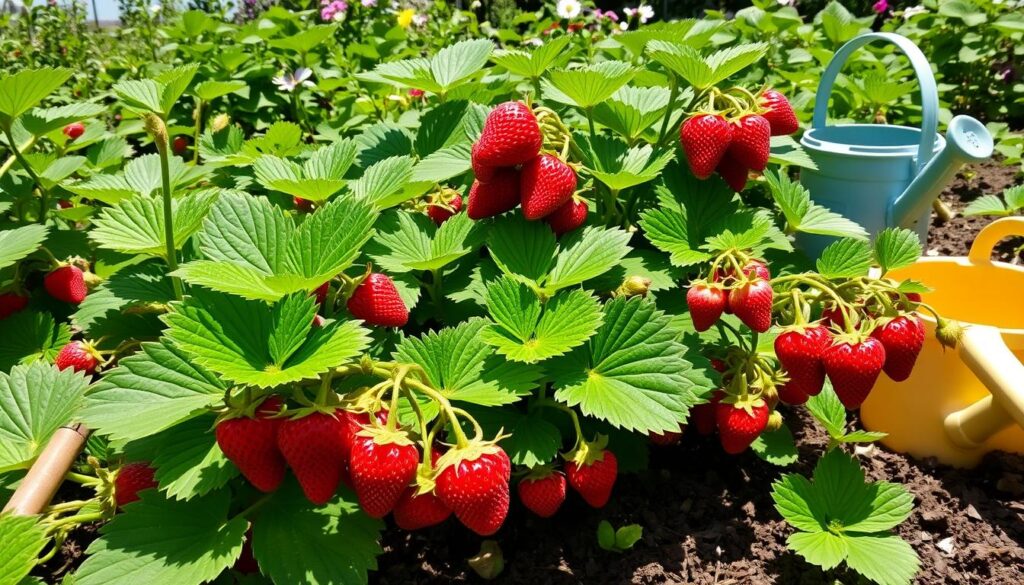
Watering is crucial for these plants. They need about 1 to 2 inches of water regularly. This ensures they grow well and produce lots of fruit.
Watering Techniques for Optimal Growth
- Water deeply but infrequently to encourage strong root development
- Use drip irrigation or soaker hoses for even moisture distribution
- Avoid overhead watering to prevent fungal diseases
- Mulch around plants to retain soil moisture
Fertilizing for Maximum Fruit Production
Organic everbearing strawberry plants do well with the right nutrients. A good fertilization plan can greatly increase your harvest.
| Growth Stage | Recommended Fertilizer | Application Frequency |
|---|---|---|
| Planting Time | Balanced Organic Fertilizer | Once at planting |
| Flowering Stage | High-Potassium Organic Fertilizer | Every 4-6 weeks |
| Fruiting Stage | Potassium-Rich Supplement | Bi-weekly during harvest |
Don’t over-fertilize, as it can hurt your plants. Moderation is key in maintaining healthy, productive everbearing strawberry plants.
“The secret to great strawberries is consistent care and attention to their specific needs.” – Garden Experts
Pest and Disease Management
Keeping your organic everbearing strawberry plants safe from pests and diseases is key. Knowing the common problems and using good management can help. This way, you can successfully care for your strawberry plants.
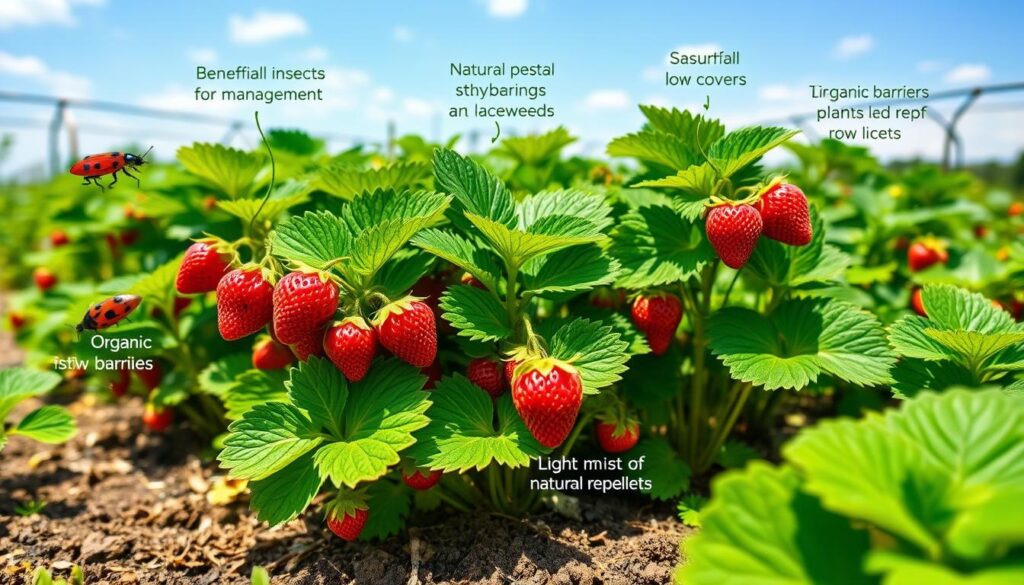
Common Pests Threatening Strawberry Crops
Strawberry plants face many pests that can harm their health and fruit. The main threats are:
- Aphids – tiny insects that suck plant sap
- Slugs and snails – which damage leaves and fruits
- Spider mites – microscopic pests causing leaf discoloration
- Birds – can quickly devour ripe strawberries
Organic Solutions for Pest Control
Using organic pest control methods can keep your strawberry plants safe. Companion planting with strategic herb selections is a natural way to keep pests away.
| Pest | Organic Control Method | Effectiveness |
|---|---|---|
| Aphids | Neem oil spray | High |
| Slugs | Diatomaceous earth barriers | Medium |
| Birds | Reflective tape or netting | High |
“Prevention is always better than cure when protecting your strawberry harvest.”
Keeping your plants healthy means watching them closely, creating a diverse garden, and using natural helpers like ladybugs. This helps control pests.
Tip: Rotate your crops and keep garden areas clean to minimize pest and disease risks in your organic everbearing strawberry plants.
Harvesting Everbearing Strawberries
Growing everbearing strawberry plants lets gardeners enjoy many harvests. These plants give fruit in waves, from late spring to early fall. This means you get delicious berries all season long.

It’s important to know when to pick for the best taste and quality. These plants have two to three smaller harvest cycles. So, you get to pick fresh, ripe berries multiple times.
When to Harvest for Best Flavor
Timing is everything for perfect strawberry picking. Look for these signs of ripeness:
- Berries with deep, vibrant red color
- Soft but not mushy texture
- Sweet, fragrant aroma
- Fully colored from tip to stem
How to Properly Harvest and Store
Care for everbearing strawberry plants means gentle harvesting. Use these tips to protect your plants and get more berries:
- Pick berries every 2-3 days
- Use clean, sharp scissors to cut the stem
- Leave a small portion of stem attached
- Harvest in the cool morning hours
After picking, store strawberries in a single layer in the fridge. Wash them just before eating to avoid spoilage. With the right mulching techniques, you can make your strawberry plants produce for weeks.
“The joy of growing everbearing strawberries is in their continuous bounty – a gardener’s delight!” – Gardening Enthusiast
Extending the Harvest Season
Growing everbearing strawberry plants lets gardeners enjoy fresh strawberries for longer. These plants offer multiple harvest times, unlike traditional ones.
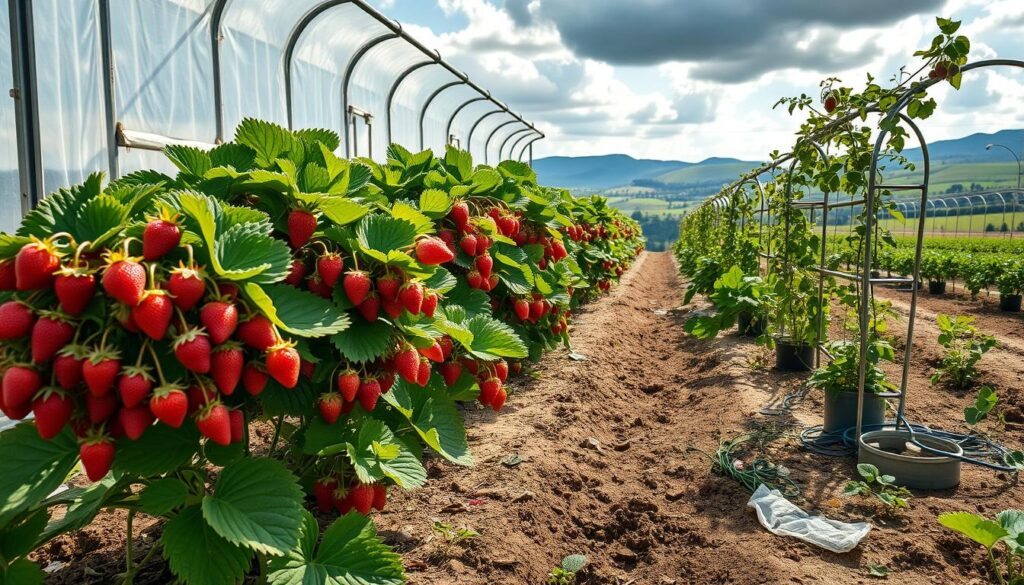
To care for everbearing strawberry plants, use season extension methods. These smart techniques turn your strawberry patch into a constant source of tasty berries.
Innovative Season Extension Techniques
- Use row covers to protect plants from early frost
- Implement low tunnels for temperature regulation
- Create cold frames to extend growing periods
- Utilize microclimates in your garden landscape
Protecting Plants During Off-Season
Winter care is key for everbearing strawberry plants. Your strategy should protect the roots and ensure plant survival.
- Apply thick organic mulch around plant bases
- Remove dead or damaged foliage before winter
- Maintain consistent soil moisture
- Consider using straw or pine needle coverings
“The secret to year-round strawberry production lies in understanding your plants’ unique needs and providing consistent, thoughtful care.” – Gardening Expert
By using these care techniques, you can extend your harvest. Strategic planning and attentive maintenance are key to maximizing your strawberry yield.
Recipes Featuring Everbearing Strawberries
Your organic everbearing strawberry plants are more than just fresh fruit. They open the door to tasty culinary adventures. With their endless harvest, these berries turn your kitchen into a place of endless creativity.

Fresh strawberries from everbearing strawberry plants are perfect for many delicious recipes. They highlight their natural sweetness and bright flavor.
Delicious Treats to Make with Your Harvest
- Classic Strawberry Shortcake
- Fresh Strawberry Smoothies
- Homemade Strawberry Sorbet
- Strawberry Jam Thumbprint Cookies
Preserving Strawberries for Future Use
Make the most of your organic everbearing strawberry plants’ harvest. Use these preservation methods:
- Freezing: Wash, hull, and freeze whole berries on a baking sheet before transferring to freezer bags
- Dehydrating: Slice strawberries thinly and use a food dehydrator for long-term storage
- Canning: Create homemade preserves and jams to enjoy summer flavors year-round
“The best strawberries are the ones you grow yourself and transform into something delicious!” – Garden Enthusiast Magazine
| Preservation Method | Storage Duration | Best Used For |
|---|---|---|
| Freezing | Up to 12 months | Smoothies, Baking |
| Dehydrating | Up to 6 months | Snacks, Baking |
| Canning | 12-18 months | Spreads, Dessert Toppings |
FAQs About Everbearing Strawberry Plants
Growing everbearing strawberry plants can raise many questions for gardeners. Knowing their unique traits helps you grow these fruits well in your garden. Whether you’re new or experienced, it’s key to know where to buy and how to care for them.
Everbearing strawberry varieties give two to three smaller harvests in the growing season. When picking plants, choose high-quality nurseries or garden centers that focus on fruit-bearing perennials. Local stores and online nurseries have great selections of everbearing strawberry plants.
Common Planting Challenges
Gardeners often ask about the best growing conditions for these plants. Everbearing strawberries need 6-8 hours of direct sunlight daily. They also prefer well-drained soil with a pH between 5.5 and 6.8.
If you’re having trouble with fruit production, check your soil and sunlight. Professional gardening centers can give advice on the best plants for your local climate.
Maintenance and Harvest Tips
Regular care is key for growing strawberries. Water your plants consistently, aiming for 1-2 inches of moisture weekly. Use a balanced organic fertilizer at planting, then switch to high-potassium during flowering.
By following these care tips, you’ll get the most from your strawberry harvest. Enjoy fresh, homegrown fruit all season long.

